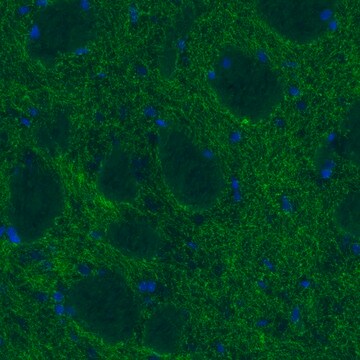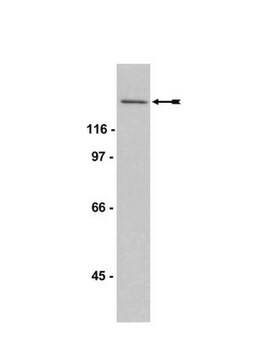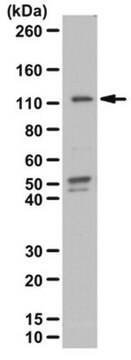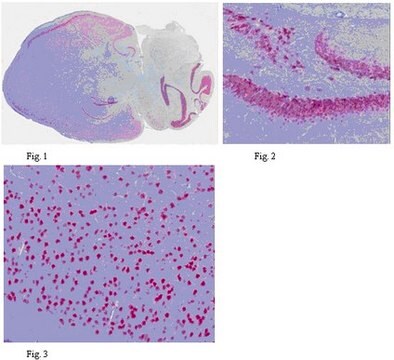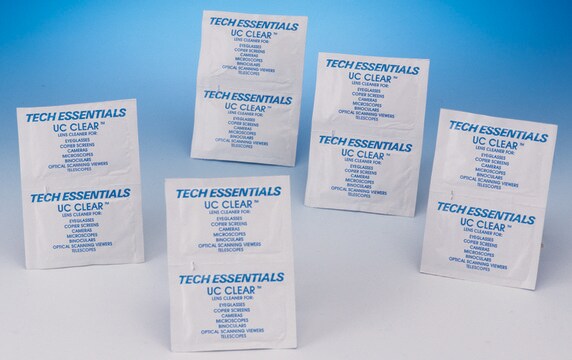ABN1675M
Anti-Nurr-1
from rabbit
Synonym(e):
Nuclear receptor subfamily 4 group A member 2, Immediate-early response protein NOT, Orphan nuclear receptor NURR1, Transcriptionally-inducible nuclear receptor, NR4A2
About This Item
IHC
WB
immunohistochemistry: suitable (paraffin)
western blot: suitable
Empfohlene Produkte
Biologische Quelle
rabbit
Qualitätsniveau
Antikörperform
unpurified
Antikörper-Produkttyp
primary antibodies
Klon
polyclonal
Speziesreaktivität
mouse, human
Speziesreaktivität (Voraussage durch Homologie)
rat (based on 100% sequence homology)
Verpackung
antibody small pack of 25 μL
Methode(n)
ELISA: suitable
immunohistochemistry: suitable (paraffin)
western blot: suitable
Isotyp
IgG
NCBI-Hinterlegungsnummer
UniProt-Hinterlegungsnummer
Posttranslationale Modifikation Target
unmodified
Angaben zum Gen
human ... NR4A2(4929)
Allgemeine Beschreibung
Spezifität
Immunogen
Anwendung
Neurowissenschaft
ELISA Analysis: A representative lot detected recombinant Nurr-1 LBDs (Courtesy of Dr. Pierre Leblanc at McLean Hospital, Belmont, MA).
Immunohistochemistry Analysis: A representative lot detected Nurr-1 in Midbrain dopamine neurons (Leblanc, P., et. al. (2015). J Vis Exp. (102):e52963).
Western Blotting Analysis: A 1:2,000 dilution from a representative lot detected Nurr-1 in HEK293T and CHO cells overexpressed with Myc-Tagged mouse full length Nurr1/Nor1/Nurr77 (Courtesy of Dr. Pierre Leblanc at McLean Hospital, Belmont, MA).
Immunohistochemistry Analysis: A 1:250-1:2,500 dilution from a representative lot detected Nurr-1 in mouse brain tissue sections.(Courtesy of Dr. Pierre Leblanc at McLean Hospital, Belmont, MA).
ELISA Analysis: A representative lot detected Nurr-1 ligand binding domain (Leblanc, P., et. al. (2015). J Vis Exp. (102):e52963).
Western Blotting Analysis: A representative lot detected Nurr-1 in CHO cells transfected with full-length myc-tagged Nurr-1 (Leblanc, P., et. al. (2015). J Vis Exp. (102):e52963).
Qualität
Immunohistochemistry (Paraffin) Analysis: A 1:50 dilution of this antibody detected Nurr-1 in mouse cerebral cortex tissue sections.
Zielbeschreibung
Physikalische Form
Lagerung und Haltbarkeit
Sonstige Hinweise
Haftungsausschluss
Sie haben nicht das passende Produkt gefunden?
Probieren Sie unser Produkt-Auswahlhilfe. aus.
Lagerklassenschlüssel
12 - Non Combustible Liquids
WGK
WGK 2
Flammpunkt (°F)
Not applicable
Flammpunkt (°C)
Not applicable
Analysenzertifikate (COA)
Suchen Sie nach Analysenzertifikate (COA), indem Sie die Lot-/Chargennummer des Produkts eingeben. Lot- und Chargennummern sind auf dem Produktetikett hinter den Wörtern ‘Lot’ oder ‘Batch’ (Lot oder Charge) zu finden.
Besitzen Sie dieses Produkt bereits?
In der Dokumentenbibliothek finden Sie die Dokumentation zu den Produkten, die Sie kürzlich erworben haben.
Unser Team von Wissenschaftlern verfügt über Erfahrung in allen Forschungsbereichen einschließlich Life Science, Materialwissenschaften, chemischer Synthese, Chromatographie, Analytik und vielen mehr..
Setzen Sie sich mit dem technischen Dienst in Verbindung.